If you have spent any time at all-around horses, you probably know that they are very friendly and gentle in most cases. Domestic horses have a diminished fear response vs. their wild counterparts. They have learned that most things in the human world don’t actually hurt them.
Still, sometimes an unknown situation comes up, or a threat is perceived and fear will induce the need for the horse to protect themselves. How do they do this?
Horses can escape danger by fleeing or fighting. Flight is typically the first option for a horse but, when necessary or when cornered, horses can bite, kick, strike, chase, and trample the enemy.
Table of Contents
Protection by Flight
Horses are known to be flight animals. In most cases, when a horse feels threatened, they would rather flee than fight.
Horses are built to run and run fast. In fact, their senses are so highly attuned that they usually can smell, hear, or see predators from very far away.
Their herd structure helps with this as well. As a group, they are all on the lookout. At the first sign of danger, the lead mare or stallion will often make the decision to run, with the rest of the herd following.
In most cases, the mantra of the horse is pretty much “run now, think later” (which is why many horses are labeled as “spooky”).
However, if fleeing is not an option for them, then they will fight when cornered and can kick, strike, bite, chase, and trample the perceived threat. But a horse would much rather run than fight in most cases.
Protection by Fight
The domestic horse has very limited options for flight so fight can easily become one of it’s primary defense mechanisms related to fear or self-protection.
Remember that a horse doesn’t have to be afraid to want to protect itself. A new mother, for example, may not want you near her foal even if she isn’t afraid of you. Getting too close may cause her to protect the baby.
Likewise, horses and ponies of all types can go into protection mode for basic day to day tasks like grooming sensitive areas, tacking up or being asked to do something they don’t want to do.
The following are some of the defense mechanisms used by horses for self-protection.
Biting
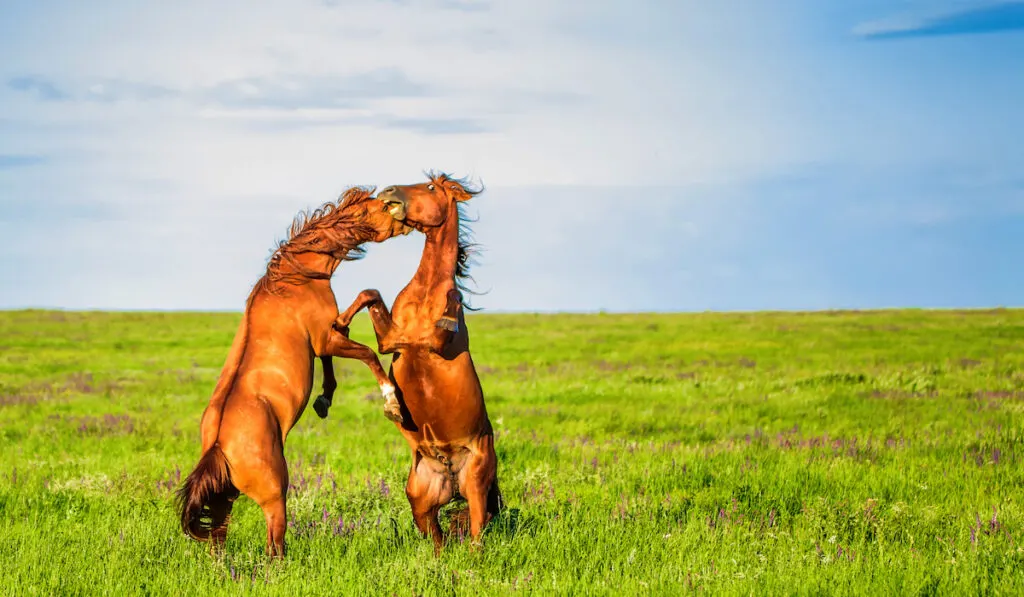
The biting behavior in horses can be observed in a variety of situations. It can be observed during play, irritation (like biting at flies), signs of a medical issue (like colic), a vice (cribbing or self-biting), fear, or protection.
If fleeing does not work for a horse, biting becomes a good option. Thankfully, most horses will warn you with their body language that they are about to bite.
Signs a horse may be about to bite include:
- Pinning their ears back
- Tensing their lips and face.
- Grinding their teeth
- Mock biting without making contact.
- Snaking their neck towards you
It can take experience to read a horse’s body language and know when they are about to bite. Always be careful when introducing new things to a horse.
Striking
When a horse uses its front legs to hit whatever is in front of him, it is referred to as striking. Sometimes they will strike or stomp with a single foot as a threat.
Often they will use two feet once the threatening object is closer. Like biting, striking is another behavior you will often see during play as well.
Just because horses are striking and biting each other, does not mean they are fighting. These mock battles help them practice in the event they really do need to protect themselves.
Here is a picture of two horses I once owned that were very good friends. The bigger horse is a stallion and the smaller is a gelding. They LOVED to play in turnout together and ALWAYS played hard as you see here.
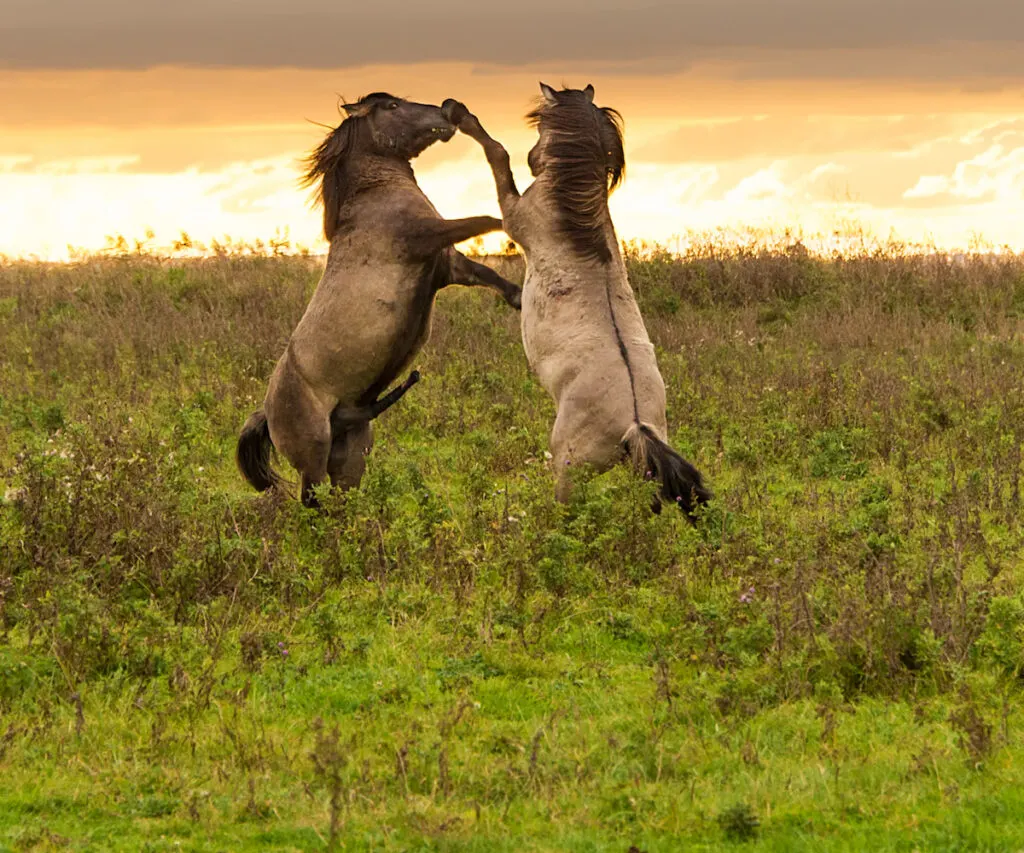
When handling horses, always position yourself well away from their front legs, outside of striking distance. Horses are big and powerful. A well-placed strike can easily kill you.
The best way to avoid being hit by a horse’s striking hoof is to not stand in front of the horse when at all possible. The sides of the horse are the safest place to bee.
Trampling
Horses that are in a defensive mode might purposefully trample a perceived threat. Most often you would see this behavior if a horse was being attacked by a dog but, they could just as easily trample a human or anything else as well.
In this case, a horse typically will run towards the thing that is scaring them and purposefully run over them. Usually, they will be striking and biting at the same time.
If you see this, know that it is no joke. The horse’s objective here is to kill the threat.
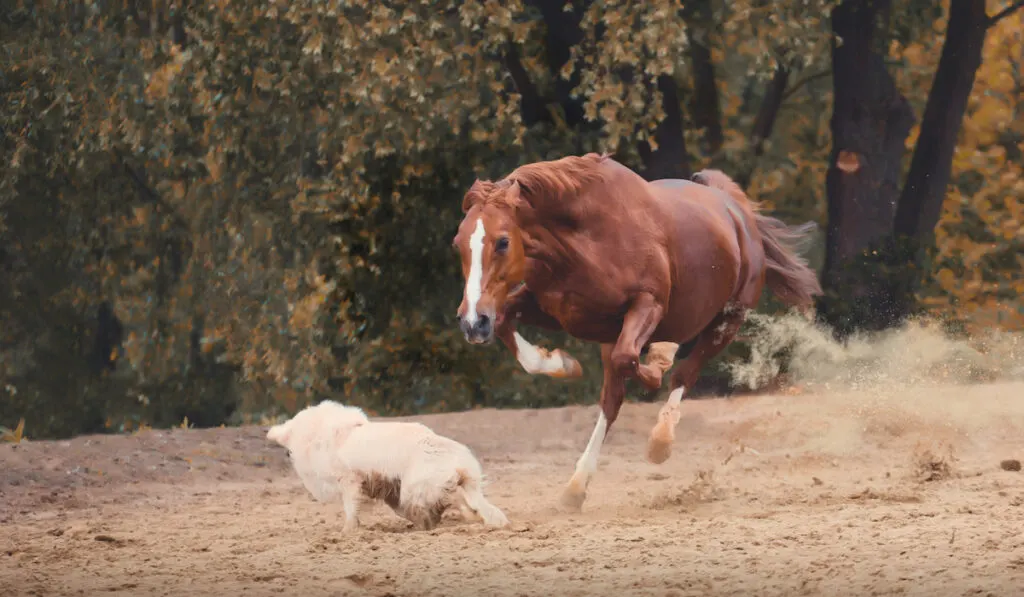
Horses are really friendly and typically won’t trample a human being knowingly. Trampling can occur in cases where they don’t see you. Surprisingly, unlike human beings, horses are not cautious to realize they are stepping on something.
An attack like this typically happens when a horse has been pushed very far over it’s fear threshold and now believes the answer is kill or be killed.
Keep in mind, this type of defensive trampling is different from accidental trampling. Accidental trampling typically happens when a human or animal gets in the way of a horse that is in flight mode.
This is most commonly seen when a horse gets loose and an unknowing person jumps in front of the horse thinking it will stop. Usually, the horse will try and avoid the “obstacle” (human).
But, sometimes they can’t and the person is trampled. This, too, can result in death and should NEVER be done.
Never, EVER step in front of a running horse.
Chasing
As mentioned, chasing is another behavior you may see when a horse is protecting itself. Often a horse will chase the perceived threat with his head low to the ground, ears back, and sometimes even showing teeth.
Kicking
Kicking is another way a horse protects itself. Usually horses kick in two different fear/protections situations.
The first is when they are in flight mode. When being chased by another horse or animal, such as a dog, a horse might kick as an attempt to disable the threatening animal.
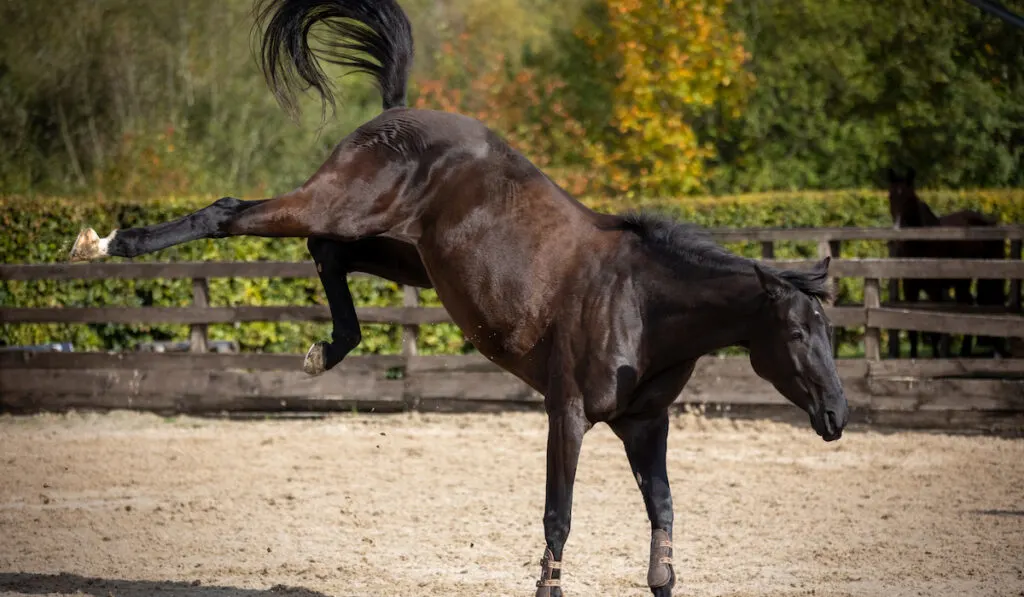
Horses can also kick out at anything that is annoying them. Whether you classify this as “protecting themselves” or just being obstinate, they are attempting to remove the annoyance from their proximity.
This is most commonly seen when saddling or cinching horses, asking a dominant horse to move out of the way, or when startling a horse from behind.
The easiest way to avoid being kicked is to never stand directly behind them and watch their body language for signs that they are thinking about kicking.
Signs of Fear in Horses
Horses, just like any other creatures, have body language as a means of communication. They can express sadness, happiness, fear, panic, or stress. The following are some of the body languages expressed by horses when they sense danger.
Ears
If the ears are flicking back and forth, it is a clear sign that your horse is afraid of something.
Ears laid straight back, flat against the head, are a threat. For experienced horse owners, there is a noticeable difference between a horse who has its ears back because they are annoyed or listening behind them vs. a horse who is displaying threatening behavior.
These subtleties in behavior can take time to learn so if you are new to horses it is best to just assume that a horse with its ears back is threatening to protect itself.

Head
Horses who perceive danger may suddenly raises their head and look in the direction of whatever caught their eye. They will continue to look until they make a decision on whether the object they sense is a concern or not.
A horse in a defensive posture will typically lower its head close to the ground and shake it up and down repeatedly as a threat. Usually their ears are back and their lips will often be tense.
While the former situation could resolve uneventfully, you can be sure that in the latter, this horse is very serious about potentially attacking and should be given a wide berth.
Tail
Horses that are scared will often clench their tail tight to their back end. Much like a dog who is scared will often put his tail between his legs.
This tucked tail is mostly seen for horses in a fear state that are thinking about leaving (flight). A horse in fight mode, however, will typically have a natural tail carriage.
Showing The White of The Eyes
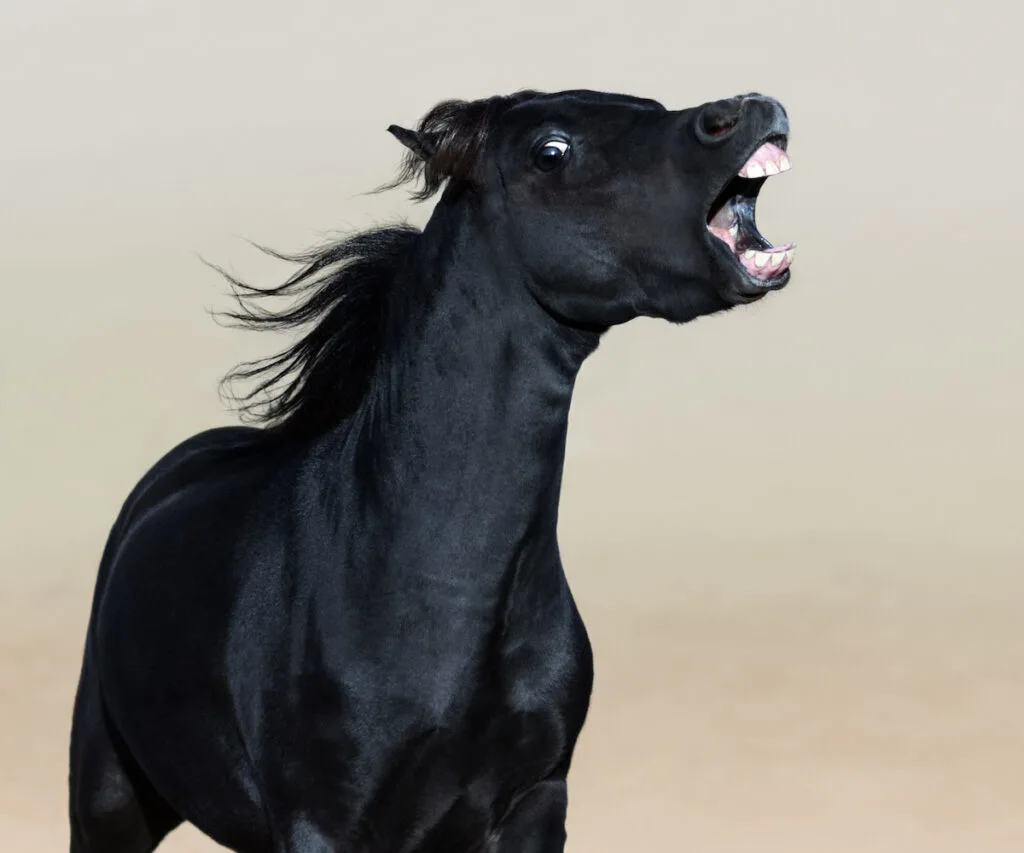
While some horses naturally have white showing in their eyes all the time (like appaloosa’s for example), many horses will show the whites of their eyes when afraid.
This sign of fear is most prominent in a horse whose eyes are normally fully pigmented. The eye itself doesn’t change color or anything. Rather, the eyelids open up completely to allow the horse to see better, often exposing eye white.
Most often the eye white will be most visible on the top or sides of the eye, depending on the direction of the scary object the horse is looking at.
For your own horse, you would be able to easily tell if your horse is displaying “normal” eye white or excessive eye white as a sign of fear.
Snorting
When your horse snorts, he closes his mouth and raises his head high and lets out air through his nose. This causes a very loud noise from the nostrils.
In a herd situation, this is a clear indicator that danger may be near. Horses who hear another horse snort will often react and look for the danger as well.
Usually when snorting is related to fear it is accompanied by a raised head and very alert ears and eyes.
Other Situations a Horse Might Go into Protection Mode.
Mares Protecting Their Babies

Almost every animal in nature has some kind of protective reaction when it comes to their young. Horses are no different.
If a mare perceives any kind of threat, she will act by laying back ears, shaking her head, pawing, biting and striking. If the situation forces her to fight, she uses her hind legs to deliver strong kicks and her front legs to strike.
Just because your mare loves you the day before she has a baby, don’t assume she will allow you to get close to a new foal. If she positions herself between you and her young one, you are best to leave them be for a few days.
I have seen a mare pick up a 300 pound man by the jacket and knock him down because he was trying to put iodine on the stump of the foals navel. When in doubt, if you must try to handle a new foal, it is best to halter and tie the mare to avoid any accidents.
Not all mares are like this. Some will happily let you in the stall with a new foal but it is better to side with caution as a protective mare is a very dangerous animal.
Stallions Protecting Their Herd.
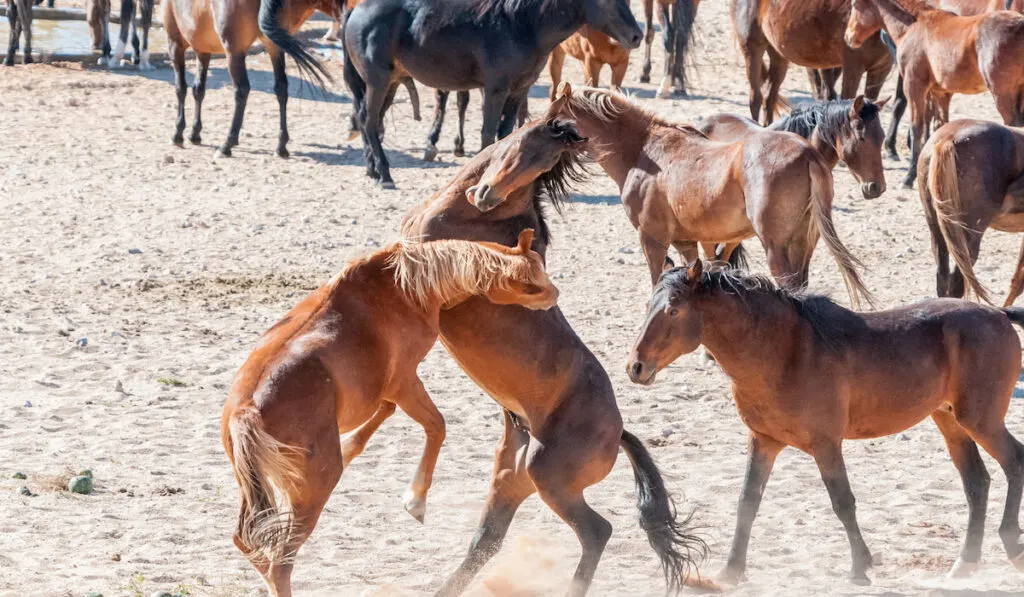
Stallions are known to protect the herds from other male horses and/or predators. The stallion will always remain at the back of the herd to offer security and ensures the herd stays together.
Stallions will defend their herd against predators if need be. This includes fighting off bobcats, mountain lions, or dogs if need be. It also means fighting off humans if threatened.
Conclusion
If well taken care of and properly trained, most horses are very friendly. Make no mistake though that if a horse should choose to protect itself, nature has made sure they are readily able to do so. Flight is the primary source of protection for most horses but, when they must resort to fight, a horse can absolutely be deadly.
